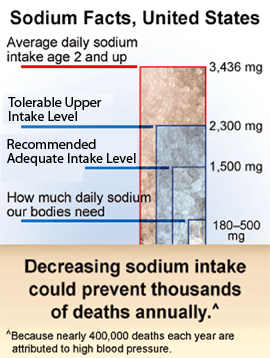 Americans Consume Too Much Sodium (Salt)
Americans Consume Too Much Sodium (Salt)
Sodium intake from processed and restaurant foods contributes to increased rates of high blood pressure, heart attack, and stroke. Decreasing sodium intake to within recommended limits could prevent thousands of deaths annually.

Americans eat too much sodium, commonly consumed as salt. High sodium consumption raises blood pressure. High blood pressure is a major risk factor for heart disease and stroke, the nation's first and third leading causes of death, respectively.
Research shows a dose-dependent relationship between consuming too much salt and elevated blood pressure. When salt intake is reduced, blood pressure begins decreasing for most people within a few days to weeks. Populations who consume diets low in salt do not experience the increase in blood pressure with age that is seen in most Western countries.
Sodium Consumption and the American Food Supply
We all need a small amount (e.g., between about 180 mg and 500 mg per day) of sodium to keep our bodies working properly.
The Institute of Medicine recommends 1500 mg of sodium per day as the Adequate Intake level for most Americans and advises everyone to limit sodium intake to less than 2300 mg per day, the Tolerable Upper Limit. Current dietary guidelines for Americans recommend that adults in general should consume no more than 2,300 mg of sodium per day. At the same time, consume potassium-rich foods, such as fruits and vegetables. However, if you are in the following population groups, you should consume no more than 1,500 mg of sodium per day and meet the potassium recommendation (4,700 mg/day) with food.
- You are 51 years of age or older.
- You are African American.
- You have high blood pressure.
- You have diabetes.
- You have chronic kidney disease.
The 1,500 recommendation applies to about half of the U.S. population overall and the majority of adults. Nearly everyone benefits from reduced sodium consumption.
- The Adequate Intake (AI) of 1500 mg per day is the recommended average daily sodium intake level. The IOM set the AI for sodium for adults at 1500 mg per day to ensure that the overall diet provides sufficient amounts of other nutrients and to cover sodium sweat losses in physically active individuals.
- The Upper Limit (UL) of 2300 mg per day refers to the highest daily level of sodium that is likely to pose no risk of adverse health effects to almost all individuals in the general population. The UL is not a recommended intake and there is no apparent benefit to consuming levels of sodium above the Adequate Intake (AI).
- The average daily sodium intake for Americans age 2 years and older is 3,436 mg.
- Since the 1970s, the amount of sodium in our food has increased, and we are eating more food each day than in the past.
The vast majority of the sodium consumed is from processed and restaurant foods; only a small portion is used in cooking or added at the table.
Data Sources:
U.S. Department of Health and Human Services, U.S. Department of Agriculture. Dietary guidelines for Americans 2010. Washington, DC: Government Publishing Office, 2010.
Institute of Medicine. (2005) Dietary reference intakes for water, potassium, sodium chloride, and sulfate. 1st ed. Washington, DC: The National Academies Press.
Institute of Medicine. (2010) Strategies to Reduce Sodium Intake in the United States. Washington, DC: The National Academies Press.
